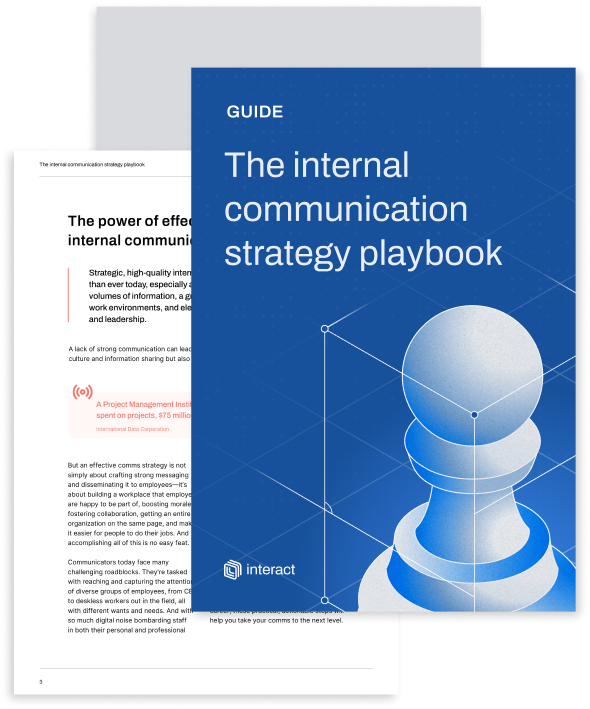Although employee engagement remains much discussed, an increased focus on keeping talented individuals happy means that employers are now just as interested in positive employee experience (EX). With so many similar terms swirling around, do you know your EX from your EXP? And, perhaps more importantly, what is the best way to improve employee experience? Our answer — great communication.
It’s no secret that the job market in 2021 has begun to thrive again as businesses reopen and consumer demand rises. The increased number of opportunities presented to employees by companies in need of talented people mean they can demand more from their workplaces; namely, an outstanding employee experience all the way from interview to daily work. To avoid losing the so-called ‘war for talent’, companies need to deliver truly great EX strategies that make them destination employers.
What is employee experience (EX)?
Many factors contribute to employee experience, including company culture, the meaning and values attached to roles, and the technologies and benefits available. Organizations have traditionally approached each of these elements separately, while employees see them as the same. Now, employers are beginning to adopt this holistic view in order to better the employee experience.
14 steps to great internal communications
Because many employees attach their feelings, wellbeing, and sense of satisfaction about work to their employee experience, organizations that don’t actively work to continually improve it, and measure its impact, risk losing top talent to organizations that do. They also risk experiencing lower productivity and engagement from those who stay but feel disengaged because of poor culture and a lack of access to collaboration and productivity tools which enable them to quickly find all the information they need. In this sense, better employee experience drives better engagement because happier employees are more inclined to participate.
Employee experience vs. customer experience

For years, organizations have placed emphasis on customer experience (CX), but we’re now seeing the rise of the ‘employee first’ approach rather than the traditional customer first approach. This is driven by the realization that the way an organization treats its people influences the way they will treat its customers. Put simply, great employee experiences enable exceptional customer experiences, so it pays to treat your employees at least as well as your customers, though preferably even better.
People who love going to work are more productive and more creative. They go home happier and have happier families. They treat their colleagues and clients and customers better.
Simon Sinek – Start with Why: How Great Leaders Inspire Everyone to Take Action
Employee experience vs. engagement

It’s easy to get employee experience and employee engagement confused. Not only do they sound alike, both concepts do slightly cross over into one another. However, there are also significant differences that people in HR and internal communications teams have grown to understand.
Employee engagement is typically driven by those that govern the company culture, and they are the ones who control the conversation, determining the subjects and themes of the engagement, and holding the power over where employees’ inputs in those conversations can begin and end.
14 steps to great internal communications
Employee experience, on the other hand, takes a far more holistic view of workplace culture. It focuses on what employees think and feel about the work and the culture around it, and it captures those sentiments so that the necessary adjustments can be made to make their working lives better.
Engagement is still vitally important in the workplace, whether that’s in the office or a remote location. It has an undeniable impact on company success, but focusing on engagement alone won’t keep employees productive and satisfied in their roles. It should be viewed as a necessary factor in delivering a positive employee experience that provides people with an affinity to the organization, rather than just seeing it as a place of work, as well as an ongoing sense of both purpose and recognition.
How to improve your employee experience

Mastering employee experience is a continual challenge as each new generation will have its own expectations that the organization will need to understand and factor into its EX strategy. Gen Z may be the new kids on the block in terms of generations active in the workplace, but their expectations should be given serious consideration as they mark a significant generational shift.
Research suggests that Gen Z workers are willing to work harder than older generations realize. But organizations also need to consider the trade-off that Gen Z employees expect for such dedication. In return, they expect strong human connections, transparency, and effective communication as part of their experience, whether that’s on-premises or, increasingly, as part of a digital employee experience (DEX).
Of course, it’s not that older generations don’t want these things too, but they have traditionally been less of an expectation and more of a ‘nice to have’ for those generations who entered the workforce when career paths were more formal and regimented.
Gen Z workers also want clarity on what’s expected of them in their roles, and they want regular, transparent feedback, including one-to-one performance reviews from line managers. Employers need to embed each of the aforementioned factors into their company culture and communicate them effectively at every stage of the employee journey, and this should start as early as pre-boarding.
All of this comes down to communication, which can be both delivered and informed through the following methods:
- Frequent surveys
- Regular feedback and reviews
- Recognition and acknowledgment
- Team-building exercises
- Multichannel communications that inform and inspire all team members
14 steps to great internal communications
When it comes to what these employees most want to hear about, intranet solutions with extensive feature sets can uncover much of that. Changing expectations and interests can be discovered through tools like Pulse Surveys, which quickly uncover what is important for respondents with simple questions. Similarly, content analytics about most and least viewed intranet pages can give communicators a vital insight into what is most impactful and what requires rethinking. Rather than simply putting out blanket messages through email, a modern intranet can give you the insights to develop custom content and then deliver it in multichannel ways, thus improving the employee’s experience of how they receive news.
Although delivering some of the factors mentioned above can appear more challenging in the age of hybrid and remote working, focusing on improving digital employee experience through an intranet or employee experience platform (EXP) can reap significant rewards.
EXP and modern intranets: one and the same

An EXP is a digital platform that allows employers to easily manage the look, feel, timing, and reach of the interactions that form the foundation of its employee experience. By definition, modern intranet software is the same.
The ways in which people define intranet software has changed over time. Early intranets were essentially dumping grounds for company documents, but some solutions evolved through the introduction of new capabilities into communication platforms. However, many of these only supported top-down corporate communications that delivered company messaging to the employees, usually through one channel (the platform itself), and restricted employees from having a voice.
A flexible, cloud-based SaaS intranet is already an EXP in that it delivers highly targeted content to employees across multiple channels through a consumer-grade platform that is easy to access and navigate. It bolsters employee experience by enabling personalization and allowing users to interact with communications in ways that suit them, while also utilizing AI to help them discover content that is relevant to their interests.
Intranet software not only ensures important top-down communications reach different segments of the workforce in a timely manner through various channels, it also encourages employees to post their own content, helping to establish a vibrant and thriving workplace community which has become essential as workforces have become more dispersed.
Additionally, one of the main areas of focus for companies like Microsoft, whose own EXP product has replaced its SharePoint-based intranet because SharePoint lacked an “employee-first focus”, is that an EXP gives every employee flexible, convenient access to information and tasks they need to make their work easier. Through consumer-grade search that integrates with the Microsoft 365 suite, Google Workspace, and other business productivity applications, packaged intranets like Interact already offer this. Likewise, a mobile intranet app gives employees the flexibility they need to access company material wherever and whenever they need.
The power of multichannel communication
Your organization could have the most creative and talented comms team in the world; it could have the strongest, most inspiring and influential leadership; and it could have the perfect selection of values, and the clearest mission and company vision. But without the right strategy and platform for communicating all of those factors to every employee, none of it matters.
A modern intranet with multichannel messaging capabilities is the essential element organizations need, not only to supercharge their communications in a way that enhances employee experience, but also to connect the right people to the right comms at the right time, and in a way that works for them. This is how today’s leading employers are placing communication at the heart of the employee experience, connecting with their people, and building thriving communities where employees keep each other inspired and engaged.


